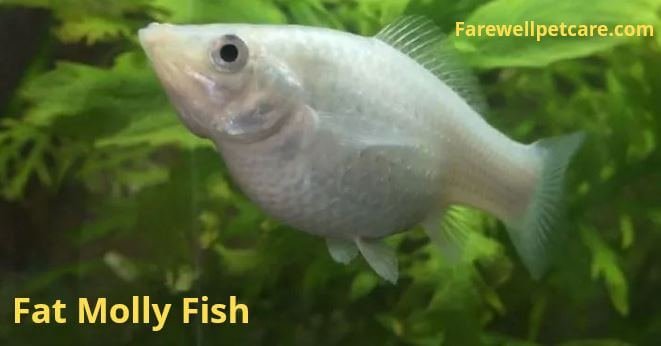Beautiful as it may appear, a very fat molly will give some food for thought. Whether you take it for pregnancy or simply fatness, you may ask yourself, “Why is my Molly so fat?”
Your molly is so fat because of pregnancy, constipation, or overeating. Pregnancy can only come by if you had sexually mature males and females in the same tank. On the other hand, the fish could have overeaten if you feed it quite often.
If you’re wondering why your molly is so fat, keep reading this article to discover four main reasons behind fatness and their remedies. Let’s dive in.
Why Is My Molly So Fat? 4 Reasons and What to Do
Your molly could suddenly look as though it may explode soon. If you see that, you’re likely to get worried about what’s exactly happening to her.
Here are four reasons why your molly is so fat:
1. Your Molly Is Pregnant

A pregnant molly will appear fat with no signs of lethargy or general weakness. Therefore, you should be concerned about anything, especially if the fish is feeding normally and roaming the water as usual.
Here are the telltale signs of a pregnant molly:
- The body is more square than round or triangular
- Black lines on the body indicate the growing babies in the belly
- The fish eats more food and frequently
- The gravid spot behind the anal fin
- The fish shows aggression against other tank mates
- She hides a lot in the tank
- Female Molly craves warmth most of the time
Molly pregnancy stages will last between 50 and 70 days, depending on your breed.
2. Your Molly Fish Is Suffering From Obesity
As mentioned earlier, fatness can indicate obesity. Your molly fish will become overweight when you overfeed her with high-calorie foods like bread, beef heart paste, or egg yolk. The result is excess fat in the body.
An obese molly fish will show one or a combination of the following signs:
- Lethargy
- Bloated abdomen
- Swimming vertically or upside down
- Increased appetite
- Labored breathing
Obesity is a serious condition you don’t want to see in your molly fish. Molly fish are known to love eating—it’s fun seeing them eat every piece of food you sprinkle in the tank. But remember to measure the quantities to avoid overfeeding.
Prevent obesity by feeding your molly food in small quantities. Always stick to the feeding schedule.
A rule of thumb when it comes to feeding mollies is to give them an amount of food they can finish in 4 to 5 minutes. For instance, you can stick to 3 flakes for every molly fish.
Most importantly, avoid too much sugar and fat in the fish’s diet as these encourage overeating.
3. You Have a Constipated Molly Fish
Constipation is a common problem in many aquarium fish, and mollies are regular victims.
Constipated mollies produce little to no waste. If the wastes finally comes out, they’re usually hard.
A constipated molly fish will have a bloated belly, indicating a non-excreted waste load. Such fish will get uncomfortable over time and even stop eating. The fish also recedes to the bottom or floor of the tank.
The main causes of constipation in mollies include:
- A poor diet lacking fiber: This is the leading cause of constipation in many aquarium fish. If you feed your molly fish commercial feed, she is likely to constipate due to the feed’s low fiber content.
- Overfeeding and bloating: After feeding the fish, the leftovers may settle on the tank floor. If uncleaned, they start to rot. In the process, ammonia is produced, leading to bloating.
The best way to manage constipation in your molly fish is by supplementing its diet with high-fiber feeds like vegetables. Moreover, blanched peas can help with bowel movement.
Find Out: How Many Mollies Should Be Kept Together?
4. Your Molly Is Probably Sick

One of the most popular aquarium conditions is called dropsy. An infected fish has a buildup of fluids inside its body cavities, making its abdomen appear swollen.
Also called bacterial hemorrhagic septicemia, Dropsy is a severe infection that can quickly kill your fish if left untreated.
You can diagnose dropsy in mollies by observing the following signs:
- Oval-shaped belly
- Protruding scales
- The molly struggles to swim
- Clamping fins
- Excreting pale feces
- Swollen and bulged eyes
Besides bacteria, dropsy can also be caused by parasites or liver dysfunction. When you notice that your molly is infected with dropsy, know that its immunity was compromised at some point.
Moreover, environmental stressors like aggressive tank mates can also predispose your fish to dropsy.
Since dropsy is contagious, ensure you quarantine affected fish in a hospital tank where you’ll treat and manage the condition. Otherwise, other fish in the tank are likely to get infected.
That said, keep your aquatic veterinarian updated about this condition. The vet will advise you and provide the necessary veterinary support, depending on the severity of the case.
Why Is My Molly’s Belly Big?
Your molly’s belly is big because the fish is probably pregnant or constipated. Furthermore, the molly fish could be overfeeding, causing the belly to swell.
As we have observed, the reasons above can make your molly develop a swollen belly. If it’s pregnancy, the swollen belly will subside after giving birth.
Interestingly, molly fish carry pregnancies because they’re livebearers.
Livebearer fish is a category of fish that give birth to fully formed fry (that can swim on their own) rather than laying eggs first.
Therefore if you notice a distended belly, the likelihood of pregnancy is high. However, the fish should remain active and eat more food.
In the case that the fish is not eating well and it’s not behaving normally, it could be suffering from conditions like obesity. Thus, be sure to make close observations and provide a high-quality, balanced diet to the fish.
Similarly, a swollen belly can be an indication of constipated molly. Constipation happens when the fish has trouble passing waste, leading to a swollen belly. You should improve the fish’s diet by incorporating fiber-rich foods like blanched vegetables or formulated fish food to stop constipation.
The other reason could be worms. The belly will appear swollen if it’s full of worms like camallanus.
How Do You Treat a Fish With a Swollen Belly?
You can treat a fish with a swollen belly by providing suitable antibiotics such as Maracyn and aquarium salt for the case of dropsy. Moreover, give it levamisole or fenbendazole medications if it has internal parasites like camallanus worms.
Once you notice your fish with a swollen belly that’s something else other than pregnancy, contact your aquatic veterinarian or a fish expert immediately. The expert will diagnose the fish and provide the best course of action as far as treatment is concerned.
Your fish could be suffering from dropsy, constipation, or obesity. Let’s find out how to treat these conditions.
Dropsy
Dropsy is not easy to cure. The best treatment you should give your fish is proper veterinary supportive care.
Otherwise, dropsy is best treated by managing tank conditions. For instance, you can move the fish to a hospital tank, where you’ll treat it with aquarium salt.
Additionally, ensure the fish in the hospital tank gets a high-quality balanced diet to help fight the condition. The food should contain Hikari Micro Wafers, blanched zucchini medallions, shelled peas, and cucumber medallions.
You can also treat it with suitable broad-spectrum antibiotics such as Mardel Maracyn.
Obesity
Obesity is best treated by offering healthier foods, including;
- Ghost shrimp
- Crickets
- Worms
- Spinach
- Lettuce and more green vegetables.
The diet should be well balanced to supply all the fish’s nutrients. Remember to follow a scheduled feeding program and give the food in small pinches to avoid overfeeding.
Constipation
The primary treatment for constipation in mollies is feeding the fish a high-fiber diet. High-fiber foods help with proper digestion to ensure the fish never constipates in the future.
Since fiber is a natural laxative, it will also help with bowel movement—expelling the accumulated feces.
Final Thoughts
If you’ve been wondering, “Why is my molly so fat?” we’ve explored the four main reasons behind the issue. We’ve also provided effective remedies to help your beloved fish regain its health and vitality.
You can create a healthier environment for your molly by addressing factors such as overfeeding, lack of exercise, improper diet, and potential underlying health issues.
Remember, the key lies in moderation, balance, and attentive care. Therefore, the next time you gaze into your aquarium, ask yourself, “Is my molly fish having the optimum weight, or is fat?”

